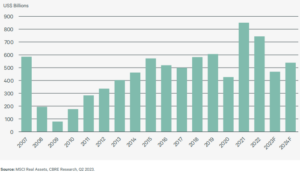Investing in commercial real estate through a private placement is well worth considering for most high-net-worth individuals once you have reviewed the fundamental differences between categories and applied your appetite for risk to appropriate security structures.
Despite uncertainties surrounding factors like sponsor quality, property specifics, the investment’s structure, or the macroeconomic landscape, the 2024 CRE market outlook remains promising for sectors like multifamily, retail, and industrial. Still, other sectors, such as office space, lag due to normalizing hybrid working arrangements.
So, why the enduring appeal of CRE investments? Not only is there a wide variety available, but investors are also drawn to potential tax benefits, current income, and growth prospects, whether they opt for passive investment through private placements or direct ownership of properties. The following outlines some reasons behind their enduring appeal.
“Land is the only thing in the world that amounts to anything, for it’s the only thing in the world that lasts.” Margaret Mitchell, Author, Gone With The Wind
Historical Returns: The proof is in the pudding.
 Over the last 15 years, investors have poured billions of dollars into CRE, as shown to the right, including roughly $1.6 Bn between 2021 and 2022, no doubt driven by its historical performance.
Over the last 15 years, investors have poured billions of dollars into CRE, as shown to the right, including roughly $1.6 Bn between 2021 and 2022, no doubt driven by its historical performance.
Private commercial real estate properties held for investment purposes over the last 25 years have generated approximately 10.3% average annual returns versus the S&P 500’s return over the same period of 9.6%, according to Forbes.1
Notably, top-performing property sectors, along with those providing greater opportunities for capital appreciation (such as value-add projects), have exceeded these returns. An example would be investments in below-market apartment complexes with upcoming lease expirations, which would afford the opportunity to raise rental income. Note that, because CRE uses leverage, Total returns have ranged from 12-20%+, far exceeding the public market index.
Furthermore, according to John Chang, SVP and Director of Research Services at Marcus & Millichap, between 2000 and 2022, price volatility is significantly lower in CRE when compared to the S&P 500. Quarter-over-quarter changes in the S&P vs. CRE prices were 6.6% vs. 1.8%, providing investors with relatively sedate values over time.
Benefits of Direct CRE Investing: Personal Opportunities
Direct private investments offer potential advantages for high-net-worth individuals and family offices who are looking to diversify their portfolios:
- Potential for Attractive Risk-Adjusted Returns
- Current Income Generation
- Diversification with Low Correlation to Stocks & Bonds2
- Tangible Assets with Intrinsic Value
- Tax Benefits (based on the investment structure)
- Portfolio Hedging & Risk Management Considerations
These potential advantages make commercial real estate a logical choice within a basket of other investments. Investors should evaluate local and national trends that may affect investment returns. We advise investors to conduct thorough due diligence to help ensure alignment with their risk profile and investment strategy.
1 Past performance is not a guarantee or indication of future performance. Investing involves risks, including the loss of principal.
2 Diversification does not guarantee a profit or protect against a loss in a declining market. It is a method used to help manage investment risk.
Image by Tom from Pixabay
